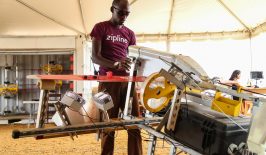Given the attention it has received in the last year, it perhaps comes as no surprise that vaccine production technology has received the Fraunhofer Institute’s internal “Technology for People and Their Environment” prize. However, even regardless of the present situation, the technology developed at Fraunhofer institutes in Leipzig, Stuttgart and Dresden seems promising.
A vaccine always works according to the same principle: the body is made to believe that there is a dangerous intruder, such as a virus, a bacterium or a parasite. The human body recognises the intruder, tries to render it harmless and generates antibodies, and the immune system learns how to react to an infection in the future.
Jasmin Fertey of the Fraunhofer Institute for Cell Therapy and Immunology IZI in Leipzig describes these proteins, which are injected during vaccination and stimulate an immune response, as a “mugshot for the immune system”. However, before the virus can be used in a vaccination, it must first undergo some transformations, most importantly removing the genetic information that could cause the virus to multiply uncontrollably in the body. Therefore, this genetic information must be destroyed during vaccine production.
Electrons Instead of Toxic Chemicals
Since 2018, the IZI has been experimenting with various methods to alter the traditional methods of vaccine production. Specifically, they have been using prototype equipment to bombard vaccines with negatively charged particles which can act to destroy the viruses’ genetic information, but leave enough of its shell to fool the immune system into a response.
Until now, dangerous chemicals such as formaldehyde have been used for this process, or the pathogens are treated in well-shielded special laboratories using gamma radiation from radioactive decay. Vaccine production on an industrial scale involves large quantities of these toxic chemicals, which is not only a challenge for occupational safety, but also a burden on the environment. “Our goal was to design a device that you can operate in a normal laboratory,” says Jasmin Fertey, “without radiation protection and without toxic substances that have to be produced and disposed of.”
Electrons have already been used in similar ways to sterilise surfaces and objects, for example surgical implants. One challenge for researchers was that the low-energy particles, in contrast to high-energy gamma rays, lose energy quickly when they penetrate an aqueous vaccination solution. In order to reliably hit all viruses, the liquid film must therefore be very thin.
To achieve this, the researchers have developed several methods. Jasmin Fertey describes one of them as a “deodorant roller”: a roller rotates through a liquid and, like the ball of the deodorant roller, picks up a thin film of liquid. This is hit by the electrons under the irradiation window, after which the vaccine with the inactivated viruses is stripped off. Ideally, this happens in milliseconds and thus is much faster than vaccine production with formaldehyde, which takes several days to inactivate the viruses. Several litres of vaccine can be produced per day in this way.
Another method is the so-called “bag module”: 10 to 20 millilitres of vaccine are packed in electron-permeable bags. Clamped between two conveyor belts, the bags are pulled taut under the irradiation window, so that a thin liquid film is created. Although this method requires more material and is more suitable for smaller vaccine quantities, it has a decisive advantage: the vaccines do not touch the production line. This means that different vaccines can be produced in quick succession without prior purification – for vaccine research such as at the Fraunhofer Institute in Leipzig, this is the method of choice.
Researchers have already tested the technology on influenza viruses, but Jasmin Fertey also sees opportunities for completely different diseases. Bacteria can also be rendered harmless with the electron method, and even parasites such as plasmodia can, according to the researchers, be specifically weakened to such an extent that they are no longer harmful and yet are not completely destroyed. This may suggest a vaccination against malaria is within reach.
However, research regarding vaccinations against Covid-19 are not currently being carried out in Leipzig: Firstly, the laboratory with the prototype equipment does not meet the required safety level. Secondly, there was no need, explains Jasmin Fertey: “In March last year, there were already 50 vaccine candidates left over from the first SARS outbreak. Many did not reinvent the wheel. We figured we didn’t have to get in line behind giant pharmaceutical companies.”
Still, she is pleased to see progress in vaccine development with competing methods. “It doesn’t make sense to focus on just one technology,” she says. “What works for one virus doesn’t necessarily work for another as well.”
Currently, the researchers are still working on details to make the product ready for the market. For example, their electron slingshot prototype is a relatively large piece of equipment and the team is working to reduce its size to better fit into existing production environments and laboratories. They already have an industrial partner who wants to manufacture and sell the device under licence in the future.
This is a translation of an original article that first appeared on RESET’s German-language site.






